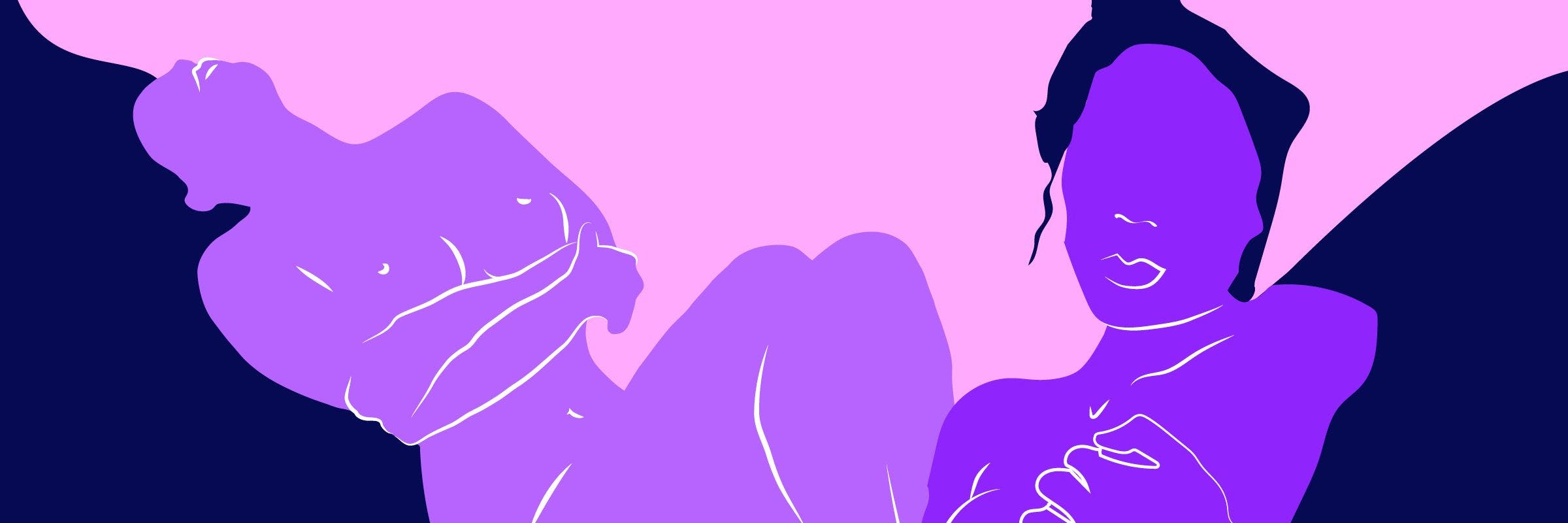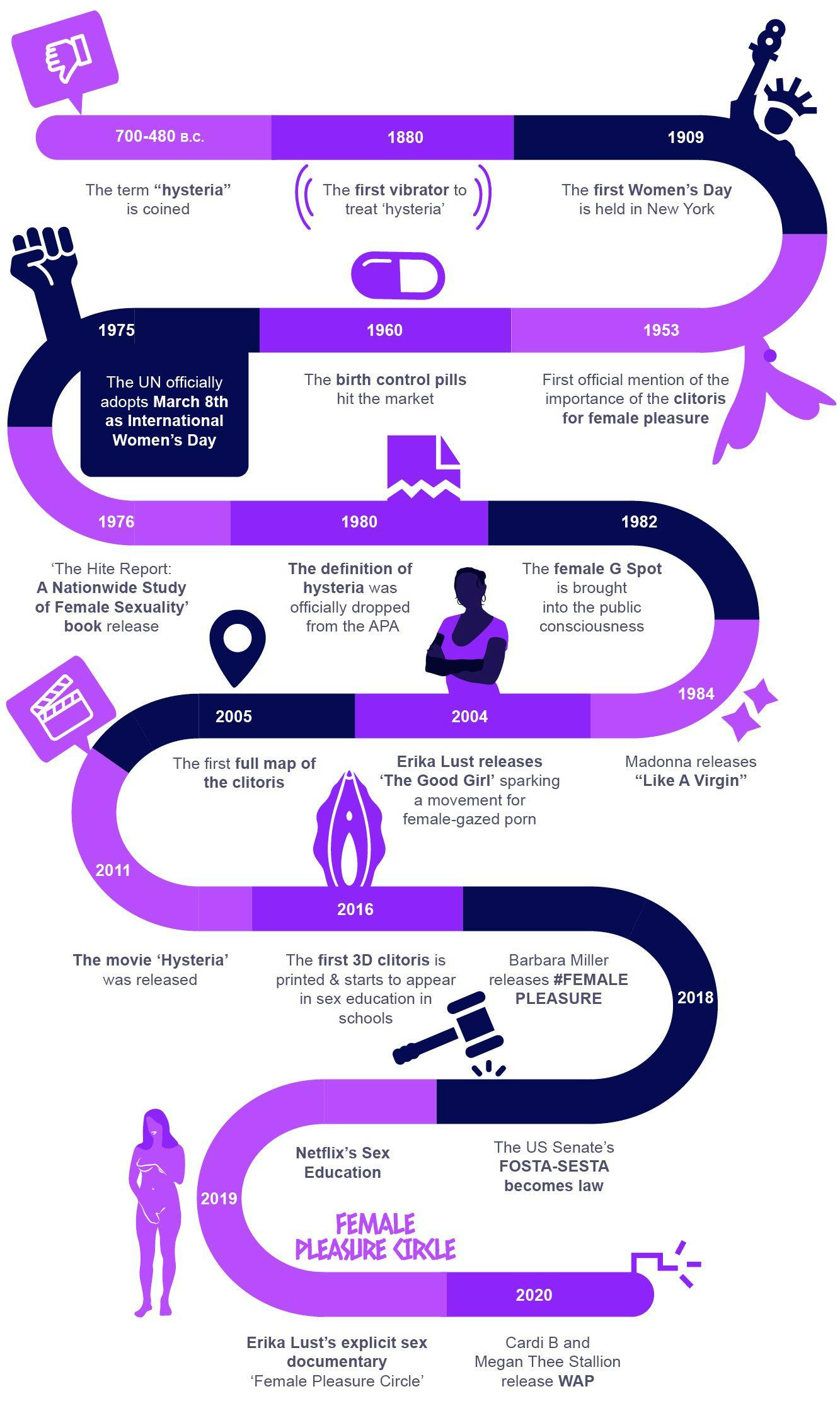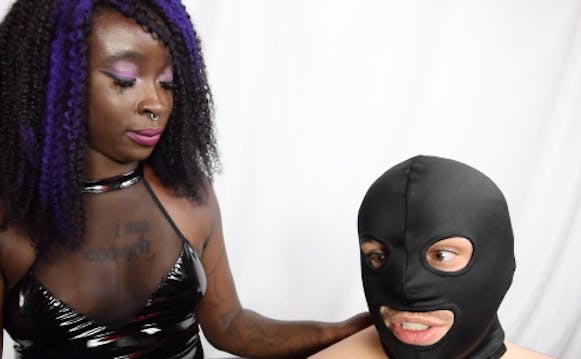

Tracing Female Pleasure: What can we learn from our history?
Tracing Female Pleasure: What can we learn from our history?
Disclaimer: Before you start reading, I would like to state that the word ‘women’, and ‘female’ as used in this article, include transwomen and non-binary femmes.
Every year on March 8, the world celebrates International Women’s Day. The very first Women’s Day was held in New York in 1909, long before the UN adopted it in 1975. Since then it has become an important day to champion women and their accomplishments around the world. Some celebrate in protest, others by investing in their personal self-care or supporting women’s rights organisations. I personally celebrate pleasure on Women’s Day.
More precisely, female pleasure.
Female pleasure is simultaneously the goal and the purpose of the women’s rights movement. Pleasure is inextricable from our social status, compressed and constrained by financial factors, safety factors, by objectification. By exploring and discussing female pleasure, one can not help but face unconscious biases within others and ourselves.
How come female sexuality is still so much more stigmatised and taboo than men’s? How come heterosexual women still experience significantly less pleasure when having sex than their male partners? I could keep listing similar statistics around sex…
As the owner of Erika Lust Films, I asked my team to put together special highlights about female pleasure across our platforms to celebrate women’s day and to raise awareness about this important topic. Regardless if you’re into the artsy vibes of XConfessions, the softness and tenderness of Else Cinema or the lusty, fun atmosphere on Lust Cinema; starting today you will find carefully curated Female Pleasure Categories on all our platforms!
As Erika, the person, the woman, the filmmaker, the wife and mother I wanted to take the opportunity to dig deeper into the topic. In order to create a culture of true gender equality, we need honest conversations and accurate information about female pleasure.
So this year, to celebrate women’s day, I decided to go on a trip. A trip of discovery of the history of female pleasure. I didn’t embark on this journey by myself. By my side was my in-house sexologist and manager of my non-profit porn & sex education platform The Porn Conversation, Avril Clarke. Our goal was: to find out what we can learn from our history in order to better understand the remaining obstacles that stand in the way of female sexuality in the 21st century.
Let us take you on a trip down pleasure-history lane..

Hysteria - in a way, women have been called “crazy” for demanding more equality and sexual satisfaction since ancient times (700 B.C - 1880)
Our research took us all the way back to ancient Greece. If you’re a woman, chances are high you’ve been called “hysterical” before. Maybe as a result of you voicing your opinion, having any feelings whatsoever or simply just for existing.
The word hysteria literally means "suffering in the uterus" and was ( and unfortunately sometimes still is…) a diagnosis used by doctors for basically anything they dislike in women’s behaviour. Or to put it in other words - the “tendency to cause trouble” - from a male perspective.
The treatments for hysteria changed over time and varied from country to country. It was the Victorians that came up with a controversial cure for the “female pandemic”: they decided the best way to cure a woman of her “dysfunctional behaviours” was to give her an orgasm, or a “fit”, as it was described back then.
So basically, men had managed to figure out that women’s negative reactions to being second-class citizens and not having ownership over their own lives, would miraculously decrease ( at least for a while) after a woman was prescribed a “medical paroxysm" aka an orgasm induced by her doctor. Genius…
Shockingly, the definition of hysteria wasn't dropped from the American Psychology Association until the 1950s. Hysteria today is no longer an accepted medical diagnosis, but the word lives on as a colloquial way to deem someone out-of-control and irrational.
When researching hysteria, we went through a lot of emotions ranging from curiosity to absolute outrage. As funny as it all sounds, let’s not forget that more serious cases of hysteria were cured with a forced hysterectomy (surgical removal of the uterus) and a
one-way ticket to the asylum.
The first-ever vibrator was invented as a medical device to cure hysteria and other illnesses (1870s)
In the 1870s British physician, Joseph Mortimer Granville invented the first electromechanical vibrator. There are different sources describing why Granville invented the vibrator. Some say it was originally invented for men while other’s say Granville invented it to cure hysteria. The device was called a “percuteur”. What’s for sure is that the percuteur was sold as a personal massager for neck pain and continued to be marketed as such for decades.
The incredible movie Hysteria (2011) directed by fellow female director Tanya Wexler tells the story of the vibrator's inception as a cure for hysteria. Doctor’s described the sessions with their female patients as ‘tedious, time-consuming and physically tiring’, so they needed a device to do the work for them. After the percuteur was put on the market, the need for ‘medical paroxysms' peculiarly decreased drastically…
Masturbation, orgasms and sex before marriage were not discussed publicly or scientifically until as late as 1953
That’s when Alfred C. Kinsey published his landmark (and controversial) book titled Sexual Behavior in the Human Female. In his book, Kinsey emphasised the importance of clitoral stimulation in reaching orgasm for women for the first time ever recorded.
Today, Kinsey is called one of the most influential Americans of the 20th century and with good reason! Alfred Kinsey’s legacy, the Kinsey Institute at Indiana University has been the trusted source for scientific knowledge and research on critical issues in sexuality for over 75 years until today.
The invention of birth control brought hope for female pleasure (1960s)
Birth control became available in the 1960s. The invention was revolutionary in many ways. Women, and other uterus owners, were not only suddenly able to enjoy sex without constant fear of unwanted pregnancy, but the widespread use of the pill also forced people and professionals of all genders to accept one simple truth: women were not just having sex to procreate. The existence of female pleasure could no longer be denied.
Till today, contraceptive methods shape women's sexual pleasure and satisfaction, according to a study from The Kinsey Institute. The study shows that many women think condoms undermine sexual pleasure, but those who use both hormonal contraception and condoms report higher overall sexual satisfaction.
The (re)appearance of the clitoris (1976 - 2016)
Did you know that during the Spanish Inquisition, a guide to finding witches cited the clitoris as the ‘devil’s mark’ of a witch, justifying the death of 9 million women over two centuries? That’s how far people were willing to go to demonise female pleasure. That should give you an idea of how revolutionary a scientific approach exploring the importance of the clitoris was later on.
Re-emphasising an idea put forth by Alfred Kinsey two decades before, The clitoris and its importance in reaching orgasm for women were brought back up in 1976 by sex educator Shere Hite in her book ‘The Hite Report: A Nationwide Study of Female Sexuality.’
It took another 6 years, until 1982 when a book titled The G Spot and Other Recent Discoveries About Human Sexuality brought this then-little-known erogenous zone—and the concept of female ejaculation—into the public consciousness.
However, it was only 15 years ago, in 2005, when researchers led by Australian urologist Helen O'Connell actually created a full map of the clitoris' internal and external structures. In 2016 in France, the first 3D clitoris was printed and started to appear in sex education in schools.
If you feel like you could need some extra insights on the clitoris, I highly recommend checking out omgyes - a platform teaching you practical techniques to enhance clitoral pleasure.
Remember ‘The Good Girl’? In 2004 I released my very first erotic short film centering female pleasure
The Good Girl was my first attempt at adult cinema. Never could I have imagined the noise my directorial debut would make! The Good Girl won the Barcelona International Erotic Film Festival's 2007 Best Spanish Screenplay award, the Venus Berlin Fair's 2007 Eroticline Award for Best Adult Film for Women, and the 2008 Feminist Porn Award for Movie of the Year.
After its release, the film was downloaded over two million times in just a couple of months. That’s when I realised: there was a HUGE demand for erotic films made from the female gaze. And just like that Erika Lust Films was born. In 2005, together with my husband Pablo, we founded our video production company. Did I know that I would become one of the pioneers of a whole movement? Hell no! To be completely honest, I just wanted to make movies that allowed women to feel good about themselves and that showed them that their pleasure was important! Now 16 years later, we have produced hundreds of erotic short films and compilations. Sometimes I still can’t believe it myself…
Why is female pleasure still such a taboo topic? (2018 - today)
In 2018, Documentary filmmaker Barbara Miller released a groundbreaking feature documentary called #FEMALE PLEASURE. The documentary shows the universal mechanisms at work that determine the position of women until today, spanning cultures, religions and continents: from Japan and India and the Somali Muslim diaspora to the Hasidic community in Brooklyn and the Catholic clergy in Europe. All protagonists have come to the same conclusion: the female body is subjected to male lust and first and foremost meant for procreation, without any regard for female sexual pleasure and autonomy.
Sexism and oppression wear many guises. We’re talking about millennia of patriarchal thinking. The structures and mechanisms behind it are exactly the same all over the world. They all go back to the same basic patriarchal feeling: the fear of female sexuality. It has to be controlled somehow. These old mechanisms are still vivid and active globally shaping our conscious and subconscious thoughts and feelings.
I could relate to Barbara Miller’s documentary a lot because in 2019, I myself decided to shoot a sex documentary called Female Pleasure Circle. Through the portrayal of five sexually confident women talking about and demonstrating female pleasure, I wanted to shatter the idea that sex is centred around the fulfilment of male pleasure & desire.
I think what Barbara Miller’s documentary and mine have in common is that we agree that celebrating women's sexual pleasure is not only enjoyable but imperative for the societal shifts we crave.
Women are inventing a new world - with pleasure
I think it is undeniable that we are witnessing a shift in society when it comes to female pleasure and sexuality in general. Female pleasure is coming out of the bedside table drawers and into the mainstream. Shows like Netflix’s Big Mouth (2017) or the groundbreaking high school drama Sex Education (2019) discussing sexual intimacy and puberty would have been absolutely unthinkable not long ago.
Female pop icons starting with Madonna, who was my personal heroine when I was a teenager, to Lil Kim, Diana Ross and most recently Cardi B and Megan Thee Stallion's smash hit WAP, have taught us the importance of showing female pleasure, not as a side product of pleasing men but to advocate for women’s rights and self-determination.
Around the world, women are taking charge of leading a new sexual movement with new demands. I believe that we are in the midst of a female pleasure revolution! In addition to health, safety and basic rights, the leaders of this revolution agree that the future must also include female pleasure. Start-ups, companies, scientific institutions and art groups run by women are redefining sexual freedom.
Courage, strength and zest for life can indeed alter societal structures. But we’re far from the end in the war against female pleasure. New challenges and obstacles are arising in our increasingly digital world. The extreme rise of online censorship of empowering and educational content about sex and female pleasure is leaving the many people who use these pages at risk of losing vital and already rare resources about female pleasure.
Women's pleasure and with it, women’s sexual health is underserved and underdiagnosed to this day. Research on sexual diseases for example is mostly based on male tissue and clinical tests on men. Even today, women are underrepresented in clinical trials whose results are not specifically categorized by gender. This lack of data and knowledge has resulted in a socially and medically neglected segment of society, accounting for 51% of the total population.
Our vision of equality is still too short-sighted. Physical health, mental health, and general well-being are all positively correlated with sexual satisfaction, sexual self-esteem, and sexual pleasure. We have to keep fighting back against the oppressive stigmas used to stifle female pleasure.
Female pleasure is revolutionary - we need to prioritise it.
If you’re asking yourself now, what you can do to fight for female pleasure, there are many answers to this question. You can support businesses and individuals that fight for female pleasure, pay for porn centring female sexuality, educate yourself and others about the importance of female pleasure!
But the best thing is always to start with yourself. After learning the history of female pleasure, there is one thing that I want to tell all of you women out there and I need you to take that and really engrave it into your soul:
Your pleasure is revolutionary. Your pleasure is ground-breaking. Your pleasure is beautiful. Your pleasure is indispensable. Your pleasure is integral to creating a better world for everyone.
My Women’s Day Gift to you
This week, in honor of International Women's Day, subscriptions to XConfessions & Lust Cinema will be at only $8 for the first month, as well as the first 3 months for Else Cinema.
Additionally, every movie on The Store by Erika Lust will be $8!

GET A FREE MOVIE














